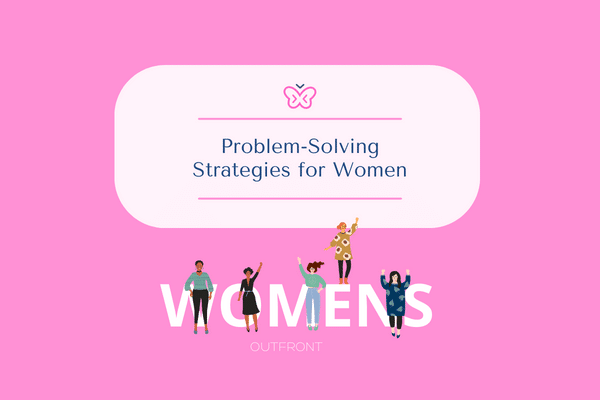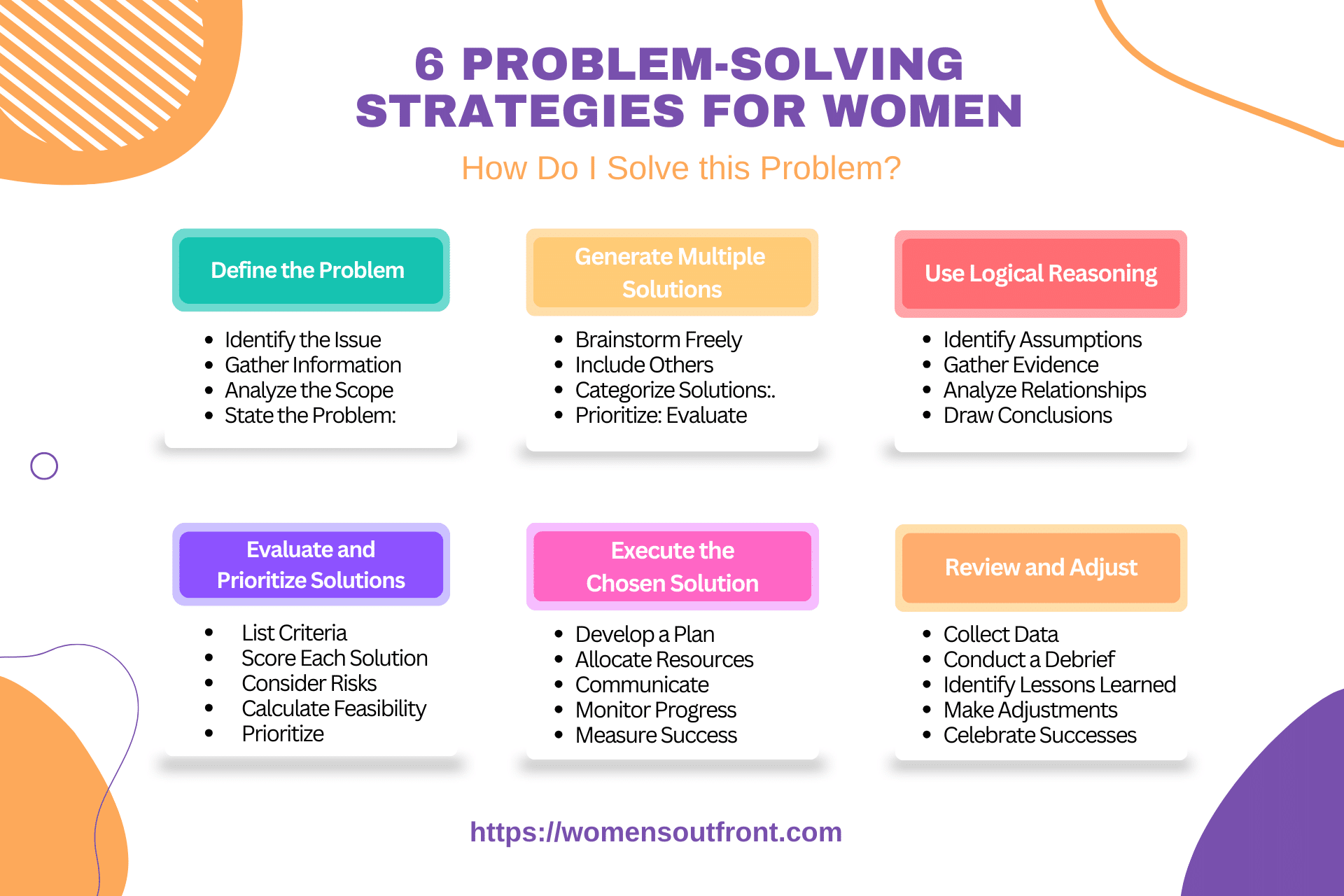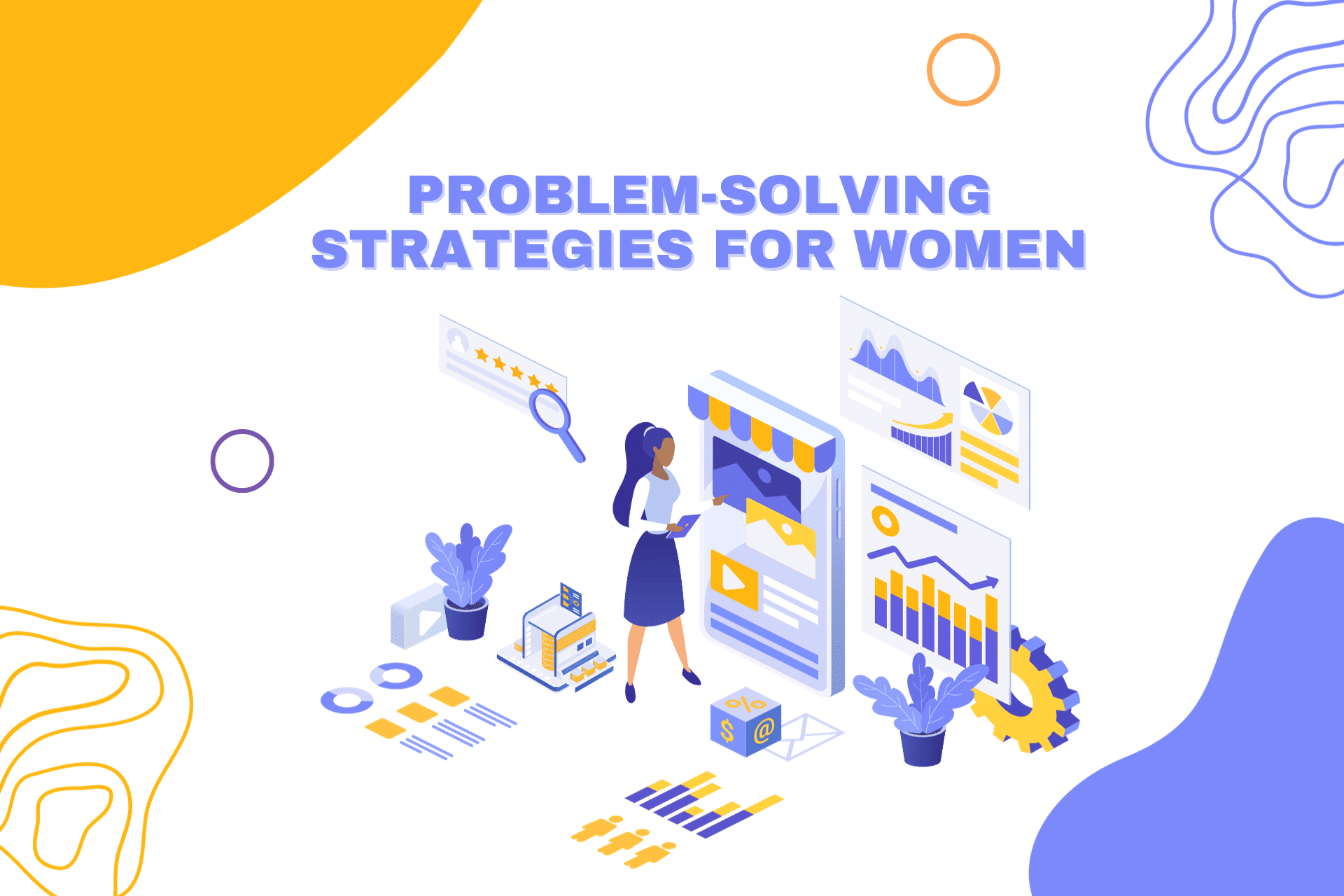Steps to Finding Your Best Solution Every Time
Welcome, incredible women who juggle careers, families, dreams, and, let’s be honest, the weight of the world sometimes! Ever find yourself stuck in a quandary that has you pacing the room or tossing and turning at night?
Don’t fret—you’re not alone, and this is precisely where problem-solving strategies can be your saving grace.
Whether you’re puzzling over how to land that big promotion, figuring out how to balance work and family, or just deciding what to binge-watch next (we’ve all been there), mastering the art of problem-solving can make your life not only easier but also a whole lot more fulfilling.
Stick around to empower yourself with a toolkit that’s as versatile as you are!
Let’s get started!
Here's What You Will Find

Key Takeaways
Problem-Solving Strategies for Women
Clearly Define Your Problem: Knowing exactly what you’re up against is the first step in any successful problem-solving journey. Be specific and objective in identifying the issue at hand.
Explore Multiple Solutions: One size doesn’t fit all, especially when it comes to solving problems. Generate various options to ensure you find the best fit for your unique situation.
Use Logic But Don’t Ignore Emotions: Logical reasoning is a powerful tool in problem-solving, but don’t forget to check in with your emotions. Emotional intelligence can provide valuable insights into how to approach a problem.
Review and Adjust: Solving a problem doesn’t end when implementing a solution. Take the time to review the outcomes and make adjustments as necessary. Continuous improvement is the name of the game.

Why Effective Problem-Solving is Crucial for Women Today
Let’s start with a simple truth: Life is complicated. And for women, these complexities can often feel like a multi-layered maze. The paths through this maze require navigation through career growth, family care, personal development, and, sometimes, societal expectations.
That’s a tall order, isn’t it? This is why effective problem-solving is not just a skill but a necessity for women today.
We often find ourselves at the center of a web of responsibilities. At work, we’re striving for excellence and leadership roles. We’re often the primary caregivers, planners, and emotional pillars at home. We’re also individuals with our dreams, aspirations, and dilemmas. Each of these roles brings its own set of challenges that demand solutions—sometimes immediate, sometimes long-term.

Learning how to solve problems effectively can lead to greater control over our lives. It enables us to make informed decisions, tackle obstacles head-on, and even foresee challenges before they arise. Mastering problem-solving skills can increase confidence and reduce anxiety, giving us a greater sense of equilibrium in life’s balancing act.
But let’s not forget: How we solve problems can be as unique as we are. Intersectionality teaches us that women face different types of challenges depending on various factors, including, but not limited to, race, economic status, and sexual orientation. Effective problem-solving strategies allow us to tailor solutions that suit the problem and who we are as individuals.
So, are you ready to sharpen your problem-solving toolkit? Let’s journey through some practical, implementable strategies designed to help you manage whatever life throws your way.
What Are We Up Against?
Recognizing Challenges in Problem-Solving for Women
Problem-solving isn’t a one-size-fits-all endeavor, especially not for women who often face unique obstacles. The complexities we encounter can vary widely depending on factors like our professional roles, family dynamics, cultural expectations, and even our inner dialogues.
In the professional realm, women are frequently underrepresented in leadership roles and decision-making tables. This lack of representation can make navigating workplace issues more challenging and having our voices heard.
The traditional societal roles and expectations at home can add a layer of challenges. The ‘double burden’ of managing both a career and a household creates a scenario where we’re constantly problem-solving both big and small issues with limited time and resources.
Moreover, the emotional labor that many women are often expected to shoulder adds a layer of complexity to problem-solving. This could mean managing family dynamics or resolving conflicts within personal relationships, tasks that require significant emotional intelligence but are often undervalued.
The pervasive issue of gender bias can also hinder effective problem-solving. For instance, women’s ideas might be dismissed or not taken seriously, impacting our confidence and willingness to participate in future problem-solving scenarios.
Lastly, the experience is further complicated by intersectional challenges that involve race, socioeconomic status, disability, and sexual orientation. These factors can introduce unique problems that are not always addressed by conventional problem-solving approaches.
Understanding these challenges is the first step towards developing effective strategies to combat them. It equips us with the awareness to tailor our problem-solving techniques to our circumstances, making us more effective and empowered decision-makers.

Effective Strategies for Problem-Solving
As we navigate the labyrinth of life’s challenges, robust problem-solving strategies can make all the difference. These abstract concepts and practical tools can help us dissect complex issues and find viable solutions. While no magic formula works for every problem, having a variety of approaches in our arsenal allows us to adapt and apply the most suitable method for each unique situation.

Whether you’re tackling career roadblocks, relationship puzzles, or personal growth enigmas, these strategies are designed to equip you with the skills you need to take control.
Read on to discover these invaluable tactics and learn how to implement them daily.
Strategy 1: Clearly Define the Problem
Why Is Problem Definition Important?
The first step in any problem-solving journey is to identify exactly what you’re up against. Think of it like a GPS; it’s tough to map out a route to your destination if you don’t know your starting point. A clearly defined problem provides you with focused objectives, helping you avoid detours and distractions along the way. It gives you the lens through which to view the issue, ensuring that you’re addressing the root cause, not just the symptoms.
Steps to Clearly Define a Problem
1. Identify the Issue
Write down the problem as you understand it. This helps you put your thoughts into words and begins the process of isolating the main issue.
2. Gather Information
Collect relevant facts and data related to the problem. This could be anything from statistical evidence to emotional responses from people involved.
3. Analyze the Scope
Understand the scale of the problem. Is it an isolated incident or part of a larger pattern? Who is affected by it, and how?
4. State the Problem
After your initial analysis, articulate the problem clearly and concisely. Keep it simple, but ensure it encompasses the issue’s scope and scale.
Real-World Application of Problem Definition
Imagine you’re facing challenges with team productivity at work. Instead of simply saying, “My team is not productive,” a well-defined problem might be, “My team’s output has decreased by 20% over the last quarter, affecting our project timelines and overall departmental goals.” This clear definition includes a measurable decrease, a timeframe, and the impact, providing you with specific criteria that you can use to evaluate solutions.
By investing the time to define the problem clearly, you set the stage for more effective and targeted problem-solving. This strategy enables you to confront challenges in an organized and actionable way.
Strategy 2: Generate Multiple Solutions
Why Multiple Solutions Are Better Than One
There’s an old saying, “Two heads are better than one.” The same logic applies to solutions—having multiple options allows you to choose the best course of action. It’s tempting to grasp the first idea that comes to mind, but it may not be the most effective or sustainable in the long run.
Generating various solutions can help you see the issue from different angles, providing a broader perspective that could reveal the optimal path forward.
Steps to Generate Multiple Solutions
1. Brainstorm Freely
Give yourself the freedom to list as many solutions as possible, no matter how outlandish they may seem initially.
2. Include Others
Consult with colleagues, friends, or experts who might provide different perspectives and additional options you hadn’t considered.
3. Categorize Solutions:
Group similar ideas together to help you better assess their potential impact and feasibility.
4. Prioritize
Evaluate each option based on factors like time, cost, and overall effectiveness to decide which solutions are most worth pursuing.
Real-World Application of Generating Solutions
Let’s say you’re dealing with a consistent communication breakdown within your team. After clearly defining the problem, you might generate a list of potential solutions:
- Implement weekly team meetings.
- Create a shared project management platform.
- Offer training sessions in effective communication.
- Designate a ‘communication liaison’ within the team.
- Encourage more informal, one-on-one catch-ups.
By considering multiple solutions, you can assess the pros and cons of each and decide which are most likely to resolve the issue. You might even find that combining solutions is the most effective approach.
So, the next time you find yourself wrestling with a problem, remember not to settle for the first solution that comes to mind. Take the time to explore various options, and you’ll increase your chances of successfully resolving the issue.
Strategy 3: Use Logical Reasoning
The Importance of Logic in Problem-Solving
Emotions are powerful and can provide valuable insights, but a logical approach can be your best friend when it comes to problem-solving. Logic enables you to separate facts from assumptions, weigh evidence, and evaluate the effectiveness of different solutions. It provides a framework that can help you make decisions that are not just intuitive but also rational and justifiable.
Steps to Apply Logical Reasoning
1. Identify Assumptions
Before you begin, identify any assumptions you or others may have made about the problem. Assumptions can cloud your judgment and lead you down the wrong path.
2. Gather Evidence
Collect all the data, facts, and relevant figures to the problem. Reliable evidence is the cornerstone of logical reasoning.
3. Analyze Relationships
Examine how different elements of the problem are interconnected. Understand the cause-and-effect relationships that could impact potential solutions.
4. Draw Conclusions
Based on the evidence and your analysis, develop conclusions that are supported by rational reasoning. Make sure your conclusions address the problem you’ve defined and that they stand up to scrutiny.
Real-World Application of Logical Reasoning
Imagine you’re facing decreased customer engagement in your business. You could jump to quick solutions like ramping up marketing campaigns or offering promotions. However, by applying logical reasoning, you first identify the assumptions (e.g., “More marketing always equals more engagement”).
Then, you collect evidence, perhaps noting that customer engagement actually dropped after your last marketing blitz. Upon analyzing relationships, you might discover that customers were overwhelmed by too many promotional emails, causing them to disengage. Your logical conclusion? A more targeted, customer-focused engagement strategy could be more effective.
By taking a logical approach, you eliminate the noise and focus on what truly matters, allowing for solutions that are not just quick fixes but sustainable improvements.
Strategy 4: Evaluate and Prioritize Solutions
How to Objectively Weigh Your Options
After generating a list of possible solutions, the next crucial step is to evaluate and prioritize them. It’s easy to get attached to certain ideas, especially if they originated from you or a trusted colleague.
However, objective evaluation ensures that you choose the most effective solution for the problem, not just the most popular or convenient one.
Steps for Evaluation and Prioritization
1. List Criteria
Develop a set of important criteria for solving the problem. This could include factors like cost, time investment, and potential impact.
2. Score Each Solution
Assign scores to each potential solution using your criteria. You can use a simple scale, like 1-5, to make this process easier.
3. Consider Risks
Take into account any risks associated with each solution. What could go wrong, and how would that affect the problem and the people involved?
4. Calculate Feasibility
Look at your resources—time, money, and manpower—to assess the feasibility of implementing each solution.
5. Prioritize
Based on your scoring and risk assessments, rank the solutions according to effectiveness and practicality.
Real-World Application of Evaluation and Prioritization
Let’s return to our example of boosting customer engagement for your business. After using logical reasoning, you’ve narrowed down your solutions to a few viable options: a targeted email campaign, a customer loyalty program, and an enhanced social media strategy.
By listing your criteria—cost, potential reach, and ease of implementation—you start to weigh the options. The targeted email campaign scores high in reach and ease but could be costly. The customer loyalty program is cheaper and could have a lasting impact, but it might take longer to show results. The enhanced social media strategy is cost-effective and has a high potential reach but requires a lot of manpower.
After calculating the risks and considering your resources, you decide that the enhanced social media strategy is the most feasible and effective option.
This structured approach to evaluating and prioritizing solutions minimizes the impact of biases and maximizes your chances of solving the problem effectively.
Strategy 5: Execute the Chosen Solution
Why Implementation is the Real Test
Brainstorming and strategizing are valuable exercises, but let’s be real—the rubber meets the road at the implementation stage. All the lists, pros, and cons, and prioritizing don’t mean much if they don’t result in effective action. The execution is where you test the viability of your chosen solution and collect data that will inform future problem-solving endeavors.
Steps to Execute the Chosen Solution
1. Develop a Plan
Outline the steps needed to implement your chosen solution. Set achievable milestones and deadlines to track progress.
2. Allocate Resources
Determine the resources you’ll need—be it manpower, materials, or money—and make sure they’re readily available.
3. Communicate
Ensure everyone involved understands their role in the implementation. Clear communication minimizes misunderstandings and sets the stage for a smoother execution.
4. Monitor Progress
Keep a close eye on the implementation, adjusting the plan as needed. Don’t be afraid to make tweaks along the way if you’re not getting the expected results.
5. Measure Success
Use the criteria and key performance indicators you established during the evaluation phase to measure the solution’s effectiveness.
Real-World Application of Solution Execution
Consider the case of a non-profit organization dealing with donor attrition. After evaluating multiple solutions, they decided to implement a donor engagement program that includes personalized communication and regular updates on how donations are being used.
They develop a detailed plan, allocate staff and volunteer hours, and set a budget for the program. After communicating the plan and everyone’s roles, they roll out the initial communication to donors.
Throughout the process, they monitor metrics like donor response rates, the frequency of donations, and the average donation amount. Adjustments are made—perhaps the frequency of updates is increased, or a video message from beneficiaries is added to the communications.
The result? An uptick in donor engagement and a decrease in attrition rates, proving the effectiveness of their chosen solution.
By focusing on thoughtful, deliberate execution, you can move from being a problem “identifier” to a problem “solver,” turning your carefully considered strategies into real-world success.
Strategy 6: Review and Adjust
Why Follow-Up is Essential
So you’ve executed your brilliant plan and are ready to call it a day, right? Not so fast! True problem-solving is an ongoing process; the follow-up phase is just as crucial as any other. This is the time to assess what worked, what didn’t, and where adjustments can be made for future successes—or to fine-tune the existing solution.
Steps to Review and Adjust
1. Collect Data
Gather quantitative and qualitative data to assess the success of your implemented solution.
2. Conduct a Debrief
Get together with your team or consult with stakeholders to discuss the results. What were the victories, and where were the stumbling blocks?
3. Identify Lessons Learned
What can you take away from this experience to help you in future problem-solving efforts?
4. Make Adjustments
Use your findings to tweak your current strategy or to inform future initiatives. If something isn’t working as anticipated, don’t hesitate to return to the drawing board.
5. Celebrate Successes
Don’t forget to acknowledge what did go well. Recognizing accomplishments can boost morale and make your next problem-solving endeavor even more effective.
Real-world application of Review and Adjustment
Let’s revisit the non-profit example. After seeing an increase in donor engagement, the organization doesn’t just rest on its laurels. They collect data on which forms of communication had the most impact, which donors increased their donation amounts, and which updates were most well-received.
During a team debrief, they realized that video updates from beneficiaries had a significant impact but also recognized that the frequency of communications could be optimized. As a result, they decided to include more video content and tweak their communication schedule.
By constantly reviewing and adjusting, the organization sustains its initial success and builds upon it, refining its approach for even better results in the future.
Remember, problem-solving isn’t a one-and-done activity. Consistent review and adjustment ensure that you’re always improving, learning, and, most importantly, solving those pesky problems that life loves to toss your way.
Can Technology Help You or Complicate Things?
Ah, technology—the double-edged sword!
On one hand, it offers incredible tools to make problem-solving a breeze. On the other hand, many options and constant notifications can leave you more frazzled than a cat in a room full of rocking chairs. So, how do you strike a balance?

Tech Tools to Aid in Problem-Solving
Project Management Software
Tools like Asana or Trello can help you track the progress of your problem-solving initiatives, assign tasks, and set deadlines.
Data Analytics Platforms
Google Analytics, Tableau, and other similar tools can give you the data-driven insights you need to assess the situation and measure the success of your solution.
Communication Platforms
Slack, Microsoft Teams, and similar tools can streamline communication among team members, keeping everyone in the loop.
Mind-Mapping Software
Platforms like MindMeister can help you visualize the problem and potential solutions, making decision-making easier.
How to Avoid Digital Overwhelm
Prioritize Tools
Choose only the essential tools for your specific problem. Less is often more when it comes to tech.
Set Boundaries
Allocate specific times to check notifications or updates so that you’re not constantly distracted.
Train Your Team
Make sure everyone knows how to use the selected tech tools effectively. The last thing you need is a tool that’s supposed to simplify your life, making things more complicated.
Review Regularly
Tech evolves rapidly. Make it a habit to review your tech stack periodically and adjust as needed.
So, can technology help in problem-solving?
Absolutely, if you know how to wield it wisely, the goal is to make these tools work for you, not vice versa. Choose your technological allies carefully, and you’ll be a problem-solving ninja in no time.
Feeling Lonely in the Problem-Solving Game?
No one ever said you must be a lone wolf in this problem-solving jungle. In fact, having a strong network can offer new perspectives, provide emotional support, and even divide the problem-solving workload. So, who’s got your back?
Building a Supportive Network for Collective Problem-Solving
Seek Out Like-minded Individuals
Finding people who share your problem-solving passion can be incredibly helpful, Whether through professional associations, social media groups, or within your organization.
Foster Open Dialogue
Encourage conversations where people feel safe to share their ideas and perspectives. You’d be surprised how a different viewpoint can open a problem.
Leverage Collective Intelligence
Utilize the skills and experiences of your network to tackle different aspects of the problem. Two heads (or more!) are often better than one.
The Role of Mentorship
Find a Mentor
A mentor who has been there and done that can offer invaluable guidance, helping you avoid common pitfalls and providing a trusted sounding board.
Be a Mentor
Consider mentoring others once you’re comfortable in your problem-solving skin. It’s a win-win—you help someone else while solidifying your own understanding and skill set.
Mutual Mentorship
Sometimes mentorship can be a two-way street; you each have something valuable to offer the other. Don’t dismiss potential mentors because they are younger or less experienced in certain areas.
Time for a Check-in: How Are YOU Doing?
Problem-solving can be exhilarating but also draining. It’s not just about ticking boxes; it’s about being in the right frame of mind to tackle those boxes in the first place.
The Importance of Emotional Intelligence in Problem-Solving
Self-Awareness
Awareness of your emotions can help you manage your reactions and make better decisions. It’s hard to solve a problem if you’re the one getting in the way!
Empathy
Understanding the emotional currents within a team can help you navigate through the problem-solving process more smoothly.
Emotional Regulation
Learning how to keep your emotions in check can mean the difference between a problem solved and a problem exacerbated.
Quick Emotional Self-Check Activities
Five-Minute Meditation
Before diving into problem-solving, center yourself with a quick meditation session for a few minutes.
Emotion Journaling
Jot down what you’re feeling and why. Sometimes, putting emotions on paper can give you the perspective you need.
The HALT Method
Are you Hungry, Angry, Lonely, or Tired? These basic needs can heavily influence your emotional state and your problem-solving abilities.
Learn more about how the HALT Method can revolutionize your approach to emotional well-being, offering a simple yet effective way to decode your feelings and make better decisions.
Remember, you’re not just a problem-solving machine. You’re a beautifully complex individual, capable of amazing things—especially when you’re not doing it all alone and taking care of your emotional well-being.
So, build that network, find that mentor, and give yourself an emotional tune-up. Your problems won’t stand a chance!
Are We Talking About One Problem-Solving Strategy for All? Nope!
In an ideal world, we’d have a one-size-fits-all strategy to wave at problems and—poof!—make them disappear. We’re not in a fairytale; we’re in the real world where problems are as diverse as the women facing them. That’s why it’s essential to consider the unique experiences of being a woman of color, LGBTQ+, differently-abled, or any combination of these and other identities.
The Intersectionality of Problem-Solving for Women
Cultural Factors
Different cultures can have specific stigmas or taboos related to problem-solving that may need to be considered.
Societal Pressures
Women often face societal expectations that can influence their problem-solving approaches, like the pressure to be more collaborative or to avoid conflict.
Career and Home Balance
The famous “double-duty” dilemma—juggling career and home responsibilities—often forces women to adapt unique problem-solving strategies.
What Does Research Say About Women and Problem-Solving?
Because you shouldn’t just take our word for it, let’s see what the number crunchers and brainiacs have to say about women and problem-solving.
Data-Driven Insights on Problem-Solving Strategies
Key Statistics
Women in Leadership Roles
According to a study by McKinsey, companies with more women in leadership roles are 21% more likely to outperform in profitability and 27% more likely to have superior value creation.
Multi-Tasking
Research has shown that women are often better at multitasking than men, an essential skill in problem-solving.
Collaborative Problem-Solving
A study published in the Journal of Applied Psychology found that women tend to excel in collaborative problem-solving situations.
Expert Opinions
Dr. Linda Carli
A renowned social psychologist, Linda Carli emphasizes that women often employ relational problem-solving, creating solutions that consider the well-being of all involved parties.
Sheryl Sandberg
Sheryl Sandberg, the COO of Facebook and author of “Lean In,” points out that women frequently have to navigate social complexities and biases when problem-solving, often making them more agile and adaptive problem solvers.
Understanding women’s unique challenges and strengths in problem-solving can offer a more nuanced approach to tackling issues. After all, knowledge is power, and the more you know about yourself and your potential strategies, the better equipped you’ll be to kick those problems to the curb!
Ready, Set, Solve!
Actionable Tips for Your Next Problem-Solving Adventure
Start Small
If you’re new to structured problem-solving, don’t aim for world peace immediately. Start with a smaller issue and work your way up.
Consult Your Network
Reach out to mentors, colleagues, or friends who may offer valuable insights or different perspectives.
Check Your Emotions
Remember the emotional self-check activities? Do them before making any big decisions.
Use Tech Wisely
Pick one or two problem-solving apps or tools to start with. Don’t overwhelm yourself with too many digital aids.
Reflect
After solving a problem, take time to review what worked and what didn’t. Adjust your strategy for next time accordingly.
It’s time to embrace these actionable tips and take your problem-solving skills to the next level.
Let’s Cap It Off
In this enriching journey, we’ve provided you with a roadmap of research-based strategies and real-world tips designed to make you a problem-solving dynamo. So, why keep all this newfound knowledge to yourself?
Share this post with other incredible women who could benefit from these strategies. Together, we can build a community of empowered, problem-solving women.
And remember, if you ever have questions or need a bit of extra guidance, we’re just a message away. Let’s conquer those challenges, shall we?
More on Problem-Solving

Independent Woman’s Relationship Problems: What No One Tells You!
Related Articles
Financial Resilience: 10 Steps That Will Completely Transform Your Financial Life!
Mastering Organizational Resilience: 7 Insider Strategies for Bulletproofing Your Business!
Entrepreneurship, Career Development
Operational Resilience: The Game-Changer Strategies Every Business Leader Needs to Know!
Career Development, Entrepreneurship
50-30-20 Rule Revealed: Budget Like a Pro and Save More!
Can Money Buy Happiness? It Pays for Pedicures, Not Peace of Mind!



